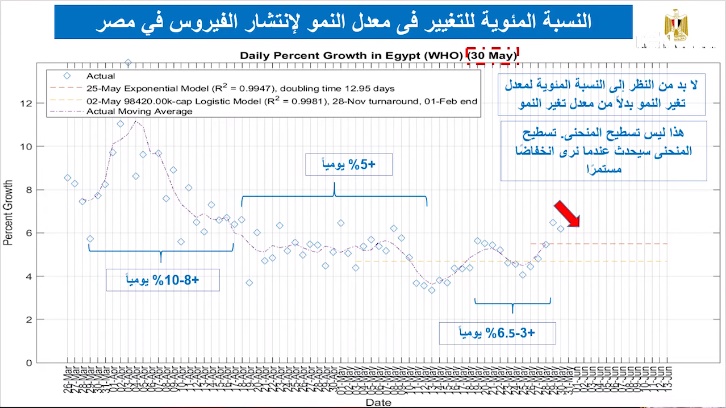Egypt could reach 100,000 or even one million cases of the coronavirus in the future under a governmental hypothetical scenario, Egypt’s higher education and scientific research minister Khaled Abdel-Ghaffar said on Monday.
“We may reach 100,000 or a million [cases]. All scenarios of epidemics in the world are possible, especially in a country of 105 million people,” the minister said in a televised statement.
“Thus, the rates of the spread [of the virus] and the rates of the increase in the numbers [of cases] are likely over a period of time,” he added, stressing that prevention measures can help avoid an “undesired” surge in numbers.
Egypt has so far reported 24,985 confirmed cases of the virus, including 959 deaths.
Hisham El-Askary, a professor in earth science at Chapman University, US, told the briefing that it is statistically "impossible to rule out that Egypt will not reach 50,000 cases."
Abdel-Ghaffar and El-Askary, whose research team works with Egypt’s higher education ministry, shared their updates on projections presented by the minister last month.
The minister said on 21 May that the true number of coronavirus infections in Egypt could be over 71,000 even though the health ministry had only recorded 14,229 confirmed infections.
Those numbers, according to Abdel-Ghaffar, were based on a hypothetical model that assumes that the official recorded cases are fivefold lower than the actual numbers.
The minister said in Monday's statement that based on that hypothetical model Egypt may have over 117,000 cases at present.
Abdel-Ghaffar explained that the new updates are taking into consideration all the changes that happened recently; since the statistical models used by the ministry are “dynamic” thus they are altered on a daily basis.
According to the higher education minister, all numbers predicted by the ministry based on increasing rates in the past (hindcasting) have been so far relatively accurate.
“On 4 or 5 June we will reach 30,000 cases, and it’s not implausible to reach 40,000 cases between 10 to 13 June,” Abdel-Ghaffar said.
The number of cases in Egypt is still increasing exponentially in a horizontal manner, which means that the inflection point is still not in the horizon, El-Askary said.
He stressed that it is now scientifically "impossible to rule out that Egypt will not reach 50,000 cases."
According to El-Askary, those models are based on the data collected by the health ministry, and they are used to predict the future to predict the timing of the peak, and when the virus will recede.
He explained that the predictions cannot be 100 percent accurate, but they are sufficient to mimic the future.
According to Abdel-Ghaffar, Egypt's curve is yet to transfer into the bell-shaped curve which indicates that the outbreak is receding like the current curve in Italy which has a decreasing daily infection rate.
Egypt is still sustaining an R0 value (which indicates how contagious the virus is) of 1.4, meaning that every 10 infected people transmit the disease to 14 others, Abdel-Ghaffar said, explaining that the ultimate goal is to have an R0value less than one.
The minister explained the daily percentage of virus growth in Egypt, saying that at the beginning of the outbreak it was between and percent and 10 percent, then it became at an average of five percent. However, when the daily cases exceeded 1,000 the percentage increased to 6.5 percent.

Daily percent growth in coronavirus cases in Egypt (Source:TeN TV channel)
According to Abdel-Ghaffar, this rate is very important since many forecasts are based on it, especially when predicting the inflection/turnaround point, or the zero case point (the end of the outbreak).
The ministry also uses satellite footage to examine the relationship between people’s movement and the increase in the number of cases and deaths.
He explained that the relationship between the amount of emissions from human activities and the number of new cases is used to indicate if restrictive measures like lockdowns or curfews have an effect on the increasing rate.
“When there have been lots of human activity, infections increased, and when movement decrease so does the number of infections” El-Askary explained.
Abdel-Ghaffar said that the rate of emissions resulting from human activities is critical for decision-makers.
He explained that, for instance, the ministry detected the most human activities emissions in Cairo governorate; so consequently, the health ministry increased its preparations in the region to contain new cases, as cases were expected to increase in the governorate.
The minister also shared the ministry’s efforts since the start of the outbreak, saying that besides statistical modelling using big data, the ministry has conducted several clinical trials in Egyptian universities and research centres.
According to the minister, Egypt has conducted over 50 out of a total of 64 clinical trials conducted in Africa, and more than all Middle Eastern countries.
The minister added that the ministry is researching the virus gene sequencing, treatment protocols, and plasma treatment. He added that they are also working on vaccines that are now in the animal trials phase.
Short link: